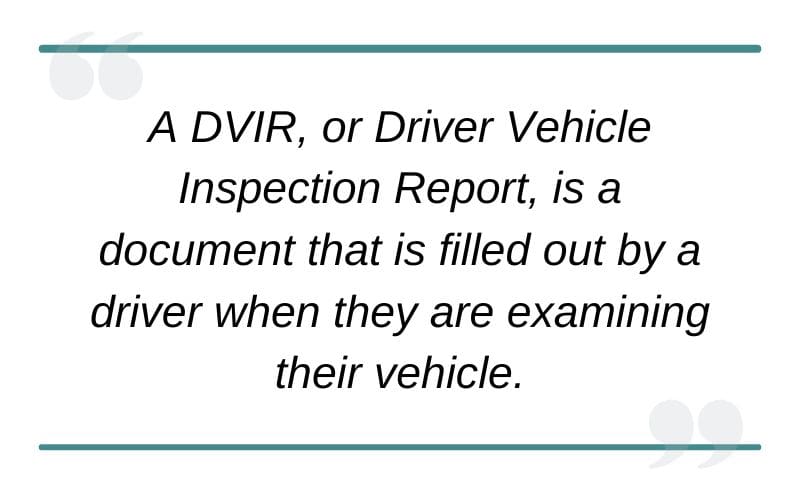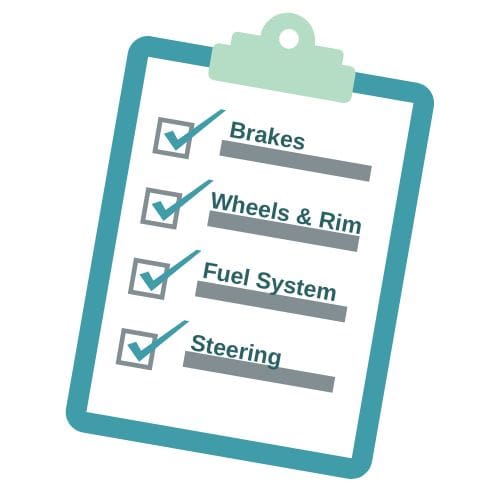
If you’re a commercial vehicle owner, you better know about DVIRs (driver vehicle inspection reports). DVIRs are an essential part of ensuring your vehicles are road-ready and up to safety standards. The DVIR helps to ensure that all deliveries are made safely and efficiently. In the past, DVIRs were only used by truck drivers. However, with the rise of online shopping, they have become increasingly important for parcel delivery drivers as well. This article will provide an overview of DVIRs: what they are, their benefits, key regulations to be aware of, and more. Keep reading for everything you need to know about DVIRs!
What is a DVIR?

A DVIR, or Driver Vehicle Inspection Report, is a document that is filled out by a driver when they are examining their vehicle. This report documents the condition of the vehicle and any issues that were found during the inspection. The report is then used by maintenance staff to ensure that the vehicle is safe to operate and fix any issues that were found.
The Evolution of DVIRs
DVIRs have been used by truck drivers for many years. In fact, the very first DVIR was created in the 1930s! The original DVIRs were very simple documents that only contained a few basic questions about the condition of the truck. Over time, however, the DVIR has evolved to become a much more comprehensive document. Today’s DVIRs contain dozens of questions that cover everything from the condition of the tires to the functioning of the brakes.
One of the biggest changes to the DVIR came in the 1990s when the US Department of Transportation (DOT) mandated that all truck drivers must fill out a DVIR before each delivery. This change helped to ensure that all deliveries were made safely and efficiently. In the years since, the DOT has made several additional changes to the DVIR. For example, in 2006, the DOT added a section on cargo securement to the DVIR. This addition was designed to help prevent accidents that can occur when cargo is not properly secured.
Today, the DVIR is an important part of many different industries. In addition to truck drivers, DVIRs are also used by bus drivers, train operators, and even some pilots! The DVIR has come a long way since it was first created in the 1930s. Thanks to the DOT’s mandate, the DVIR is now a comprehensive document that helps to ensure the safety of all deliveries.
The Key Benefits of DVIRs
There are many benefits to using DVIRs, both for drivers and for commercial vehicle owners. DVIRs help to ensure that all vehicles are safe to operate and that any issues are found and fixed before the vehicle is used.

DVIRs also help to improve communication between drivers and maintenance staff. By documenting the condition of the vehicle, the DVIR allows drivers to quickly and easily communicate any issues they find to maintenance personnel. This helps to ensure that the issue is fixed in a timely manner.
Another benefit of DVIRs is that they help to create a paper trail. Although it may not be a literal ‘paper’ trail since most DVIRs are done electronically these days, it does create a solid tracking record. By documenting the condition of the vehicle, DVIRs help to create a record of the vehicle’s maintenance history. This paper trail can be helpful if there is ever an accident or other incident involving the vehicle.
Lastly, DVIRs help to improve customer satisfaction. By ensuring that all vehicles are safe and road-ready, DVIRs help to ensure that deliveries are made on time and without incident. This, in turn, helps to improve customer satisfaction and loyalty.
How Often Should DVIRs Be Reported?
As we mentioned, a DVIR is simply a document that records the condition of a commercial vehicle. This document is important because it can help to identify potential safety concerns before they become actual problems. For example, if you notice that one of your tires is starting to look bald, you can record this information on your DVIR and then take action to fix the issue before it becomes a flat tire.
It’s important to note that DVIRs are not just for safety concerns. You should also use them to document any maintenance issues that you notice. For example, if you notice that your brakes are making a strange noise, you can write this down on your DVIR so that you can take action to fix the problem before it becomes a bigger issue.
So, how often should you be submitting DVIRs? The answer to this question depends on a few factors, such as the type of vehicle you’re driving and the amount of mileage you put on it. However, in general, you should submit a DVIR at least once every day, sometimes twice a day (once in the morning and once at the end of the day). This will ensure that any safety concerns or maintenance issues are documented and addressed in a timely manner.
Key Regulations to be Aware Of
In the United States, the Department of Transportation (DOT) requires all commercial motor vehicles (CMVs) to have a daily Vehicle Inspection Report (DVIR). Drivers are required to perform a pre-trip inspection prior to operating their vehicle and a post-trip inspection at the end of their work day. The results of these inspections must be recorded on the DVIR.
There are certain key regulations that pertain to the DVIR process that drivers need to be aware of. These include:
1. The pre-trip inspection must be conducted prior to the vehicle being driven for the first time each day.
2. The post-trip inspection must be conducted after the vehicle has been driven for the last time each day.
3. The results of both the pre-trip and post-trip inspections must be recorded on the DVIR.
4. If any defects or problems are found during either inspection, the driver must make sure that they are corrected before driving the vehicle again.
5. Drivers must keep a copy of their completed DVIRs on file for a period of six months.
6. Employers must keep a copy of all drivers’ DVIRs on file for a period of one year.
7. Drivers must notify their employer of any defects or problems found during an inspection that were not able to be corrected before driving the vehicle again.
8. Employers must investigate any defects or problems found on a DVIR and take appropriate corrective action.
9. Drivers must not operate a vehicle if they are not satisfied that it is safe to do so.
Following these key regulations will help to ensure that commercial motor vehicles are safe to operate on the roadways. Failure to comply with these regulations can result in fines and penalties from the DOT. Drivers who are found to be operating a CMV without a valid DVIR may be subject to civil or criminal penalties.
Penalties for Not Following the Regulations
As mentioned earlier, failure to comply with the DVIR regulations can result in fines and penalties from the DOT. Drivers who are found to be operating a CMV without a valid DVIR may be subject to civil or criminal penalties. Some of these penalties can include:
- Fines of up to $2,750 for each violation.
- Imprisonment for up to 180 days.
- Suspension or revocation of their commercial driver’s license (CDL).
Commercial vehicle owners who do not follow the DVIR regulations can also be subject to penalties. These penalties can include:
- Fines of up to $11,000 for each violation.
- Imprisonment for up to one year.
- Suspension or revocation of their DOT registration.
What to Include on a DVIR
When conducting a DVIR, there are certain items that need to be inspected. These items include:

- Brakes
- Tires
- Lights
- Steering and suspension
- Mirrors
- Windshield wipers and washers
- Horn
- Coupling devices
- Wheels and rims
- Emergency exits
- Vehicle’s body and frame
- Fuel system
- Exhaust system
It is important to note that this is not an exhaustive list. Drivers may need to inspect other items on their DVIR depending on the type of vehicle they are driving and the regulations that apply to that particular vehicle.
After inspecting each of these items, the driver will need to record the results on the DVIR. The DVIR will need to include:
- The date and time of the inspection
- The location of the inspection
- The driver’s name
- The vehicle identification number (VIN)
- The odometer reading
- A list of all defects or issues that were found during the inspection, including a description of each issue
- The driver’s certification that all defects or problems have been corrected
If any defects or issues are found during the inspection, the driver must not drive the vehicle until the issue has been fixed. The DVIR should be signed by the driver to indicate that the inspection was completed and that all defects or issues have been noted.
The DVIR must be kept on file by the driver and their employer for the appropriate period of time. Completing a DVIR is an important part of keeping commercial vehicles safe.
How to Make DVIR Simple and Part of Your Driver’s Routine
Conducting DVIRs can seem like a daunting task, but there are ways to make it simpler and part of your driver’s routine. Here are some tips:
- Schedule DVIRs at the same time each day so that it becomes part of your driver’s routine.
- Create a DVIR checklist that your drivers can use to make sure that they are inspecting all of the required items.
- Make sure all drivers are familiar with the DVIR process. This includes knowing how to fill out the form and where to submit it.
- Keep a DVIR form in the vehicle at all times. This way, if you find any defects during your inspection, you can fill out the form and submit it to the appropriate person.
- Review DVIRs on a regular basis to ensure that they are being completed correctly and that all defects or problems are being corrected in a timely manner.
- If possible, automate the DVIR process by using electronic DVIR forms that can be filled out and submitted electronically.

EXTRA DVIR
Making sure your drivers are completing their DVIRs is critical for ensuring compliance with FMCSA regulations, and with Elite EXTRA’s DVIR mobile app, it’s easier than ever. The app is a feature of our Elite EXTRA Routing and Dispatch software.
The EXTRA DVIR mobile app makes it easy for drivers to complete daily vehicle inspection reports (DVIR). The app’s checklist is fully configurable, so it can be customized to fit your company’s specific policy and requirements. Plus, the app ensures compliance by requiring DVIR completion before the driver can start their route. Drivers can complete the checklist right from their smartphones or tablets, and dispatchers can view drivers’ DVIR status in real time. With historical DVIR reporting, you can track past completion data within Routing & Dispatch’s reporting suite. you can view drivers’ DVIR status in real-time, so you can always be sure that your vehicles are up to safety standards.
You can check a driver’s “Hours of Service Eligibility” right when they log in to their device, and you can see if a driver is compliant with FMCSA regulations. Plus, customized reports can be built based on the vehicle that the driver is using. So whether you need to track DVIR compliance or create customized reports, the Elite EXTRA DVIR app has you covered.
Conclusion
DVIRs are an important part of keeping commercial vehicles safe. By conducting DVIRs on a regular basis, you can ensure that your vehicles are up to safety standards and avoid potential fines and penalties. With Elite EXTRA’s DVIR app, you can make DVIRs simple and part of your driver’s routine. The app is fully configurable, so you can customize it to fit your company’s specific needs. And with real-time DVIR reporting, you can always be sure that your vehicles are compliant with FMCSA regulations.
DVIRs don’t have to be a hassle, and with Elite EXTRA, they can be simple and part of your driver’s routine. Try our DVIR app today and see how easy it is to keep your vehicles safe and compliant. For more information about our DVIR app, visit our website or contact us today.
Want more industry insights?
Subscribe to our newsletter to receive weekly last mile logistics insights directly to your email inbox each week!
Sources
https://www.ecfr.gov/current/title-49/subtitle-B/chapter-III/subchapter-B/part-396/section-396.11
https://www.fmcsa.dot.gov/safety/
https://www.fmcsa.dot.gov/regulations







